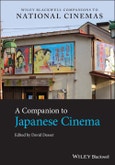Go beyond Kurosawa and discover an up-to-date and rigorous examination of historical and modern Japanese cinema
In A Companion to Japanese Cinema, distinguished cinematic researcher David Desser delivers insightful new material on a fascinating subject, ranging from the introduction and exploration of under-appreciated directors, like Uchida Tomu and Yoshimura Kozaburo, to an appreciation of the Golden Age of Japanese cinema from the point of view of little-known stars and genres of the 1950s.
This Companion includes new resources that deal in-depth with the issue of gender in Japanese cinema, including a sustained analysis of Kawase Naomi, arguably the most important female director in Japanese film history.
Readers will appreciate the astute material on the connections and relationships that tie together Japanese television and cinema, with implications for understanding the modern state of Japanese film. The Companion concludes with a discussion of the Japanese media’s response to the 3/11 earthquake and tsunami that devastated the nation. The book also includes:
- A thorough introduction to the History, Ideology, and Aesthetics of Japanese cinema, including discussions of Kyoto as the cinematic center of Japan and the Pure Film Movement and modern Japanese film style
- An exploration of the background to the famous story of Taki no Shiraito and the significant and underappreciated contributions of directors Uchida Tomu, as well as Yoshimura Kozaburo
- A rigorous comparison of old and new Japanese cinema, including treatments of Ainu in documentary films and modernity in film exhibition
- Practical discussions of intermediality, including treatments of scriptwriting in the 1930s and the influence of film on Japanese television
Perfect for upper-level undergraduate and graduate students studying Japanese and Asian cinema, A Companion to Japanese Cinema is a must-read reference for anyone seeking an insightful and contemporary discussion of modern scholarship in Japanese cinema in the 20th and 21st centuries.
Table of Contents
Notes on Contributors viii
Acknowledgements xv
Introduction 1
David Desser
Section 1 History, Ideology, Aesthetics 25
1 Kyoto - The “Hollywood of Japan” 27
Diane Wei Lewis
2 The Pure Film Movement and Modern Japanese Film Style 49
Laura Lee
3 Shiraito Redux: Text, Body, Desire from Kyoka to Mizoguchi 67
Ayako Saito
4 The Adventures of Uchida Tomu 90
Daisuke Miyao
5 Yoshimura Kozaburo and the Working Woman in the Old Capital 106
Alexander Jacoby
6 Calico-World in Rainbow Colors: The Aesthetics of Gender in 1950s Toei Jidaigeki 130
Junko Yamazaki Copyrighted Material
7 Silverscreen Dreamboats and the Polyvocal Address 149
Earl Jackson
8 Mad, Bad, and Beautiful: Revisiting Kurosawa’s Women 174
Dolores P. Martinez
9 Biographies of Loss: The Cinematic Melancholy of Kawase Naomi 193
Erin Schoneveld
10 Shaping the Anime Industry: Second Generation Pioneers and the Emergence of the Studio System 215
Laura Montero-Plata and Marie Pruvost-Delaspre
11 Shapeshifting in Anime: Form and Meaning 247
Richard J. Leskosky
Section 2 The Old and the New 269
12 Ainu in Documentary Films: Promiscuous Iconography and the Absent Image 271
Marcos P. Centeno-Martín
13 Modernity in Film Exhibition: The Rise of Modern Movie Theaters in Tokyo, 1920s-1930s 294
Chie Niita
14 Female Stardom and National Identity in Postwar Japan 316
Jennifer Coates
15 Wild, Sexy, and Funny: Toei Does “Pink” 334
Laura Treglia
16 Behind the Voice that Brought Peace: The Emperor as Hero in The Emperor in August 352
Griseldis Kirsch
17 Queer Time in Summer Vacation 1999 369
Nina Cornyetz
18 Horror Old and New: Nakata Hideo’s Ringu (1998) between J-Horror and Hibakusha Cinema 382
Olga V. Solovieva
19 Youth, Trauma, and Contemporary Japanese Cinema 401
Jay McRoy
20 “Female Director”: Discourses and Practices in Contemporary Japan 421
Alejandra Armendáriz-Hernández and Irene González-López
21 The Dying Art of Japanese Cinema 446
Kirsten Cather
Section 3 Intermediality 469
22 Before Media Mix: The Electric Ecology 471
Alexander Zahlten
23 Gosho and the Gagman: Scriptwriting at the Time of the Talkie Crisis 493
Lauri Kitsnik
24 Inventing Television through Film: Japanese Cinema and TV, 1953-1963 510
Aaron Gerow
25 ’Scope and the City: Reframing a Modern Metropolis 529
Jasper Sharp
26 Bodies in Motion: Japanese Film of the 1964 Tokyo Olympics Era between Mass Culture, Media, and Memory 547
Ryan Cook
27 Adaptation as Cinematic Translation: Murakami Haruki and Ichikawa Jun’s Tony Takitani 568
Mika Ko
28 Blockbusters in Japan: Hit Film Culture and the Rise of Fuji Television as Commercial Film Studio 591
Rayna Denison
29 Hani Susumu, Nouvelle Vague in Japan and Processive Cinema 612
Takuya Tsunoda
30 The Cultural Turn in Post-3.11 Documentary: Kamanaka Hitomi’s Accented Documentary 639
Mitsuyo Wada-Marciano
Index 658








